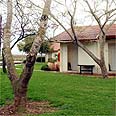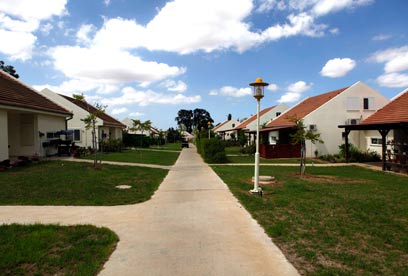

Kibbutz Hulda, in central Israel, is a telling example.
The kibbutz, which is remembered as a staging ground for Jewish convoys trying to break the Arab siege on Jerusalem during the fighting around Israel's 1948 creation, has seen its membership plunge to about 110 people, from twice that at its peak in the early 1980s. That was when the kibbutz movement as a whole began to be pummeled by economic crisis and the lure of greater freedom outside.
Like many other kibbutzim, Hulda has shut down its communal dining hall. In a major inversion of the movement's key principle - equality - Hulda members no longer receive equal allowances but are paid according to the type of work they do, with managers making more than simple workers. The kibbutz, which was once home to author Amos Oz, supports itself largely through members' salaries from outside jobs, agriculture and by leasing land and buildings to outsiders.
And like nearly three dozen other kibbutzim, it's building a new neighborhood for non-members who want to enjoy the benefits of rural life - without having to share the kibbutz's founding values. On the edge of the kibbutz, separated from it by a narrow road, the scaffolding, whirring drills and pounding hammers herald the coming of a hoped-for lifeline.
Still under construction, the 110 homes have already been sold, said project manager Itzik Gedalia. The homes will average 1,750 square feet - about twice as big as the average kibbutznik's and significantly larger than most Israelis' apartments. Residents will own these homes, unlike the kibbutzniks, who long rejected the idea of private property.
"When no one wanted to look at us, it looked like the only way to keep Hulda alive," said Amotz Peleg, who was born there 67 years ago. "You can't keep a community alive with 100 members and a few tenants. You can't support a clinic, nursery schools, a grocery."

Loosening of the original kibbutz framework (Archive photo: Tsafrir Abayov)
Because the State owns the land on which the kibbutzim stand, the communal farms don't get a cut from the house sales. Still, Hulda hopes the infusion of new families will help keep communal institutions like the local school, clinic and grocery alive, because non-members pay to use them, Peleg said.
The loosening of the original kibbutz framework has also drawn back some former kibbutzniks who left their homes looking for greater freedom, and they're now returning as members. Peleg's own daughter, Galia Peleg, is one of them.
"As soon as Hulda privatized, that was the thing that made me go back," she said. "I understood I could preserve my quality of life materially and benefit from the community life as well." Her brother is also in the process of becoming a member.
According to movement officials, the total kibbutz population today is close to 127,000, up from 115,300 five years ago - about 1.6% of Israel's population. About 4,000 of those people are not members. At the movement's height, about 3.5% of Israelis were kibbutzniks.
Today there are about 270 kibbutzim across the country, and they still hold economic weight. Their factories and farms produce 9 percent of Israel's overall industrial output, worth $8 billion, and 40 percent of its agricultural output, worth more than $1.7 billion.
Some kibbutzim thriving financially
The brainchild of eastern European socialist Zionists, the kibbutz quickly became a symbol of the pioneering and socialist ethos of the country's early years. The first one was Degania, founded on the banks of the Sea of Galilee in October 1910.Kibbutzniks built many of the settlements that defined and defended the country's early borders. Many of Israel's early political, military and business leaders came from kibbutzim, and the communes drew thousands of foreign volunteers.
The movement was unique in the annals of socialism because no other voluntary form of collectivism attracted so many devotees. Their socialist and Zionist ideology was based on the principle of shared agrarian labor, shared income, shared meals and shared housing for children. Even individual life decisions - like a choice for university studies - could be subject to a vote.
But over the years the idea lost its utopian communal gloss, mirroring Israel's shift to an industrialized free market and an emphasis on individual goals. Thousands of younger members decamped to cities in the 1980s, chafing at the restrictions of kibbutz life. Meanwhile, the kibbutz's political patron, the Labor Party, lost the political and economic hegemony that guaranteed the collectives favored treatment.
Kibbutzim groaned under billions of dollars of debt that burgeoned during hyperinflation in the 1980s, driving some to the brink of bankruptcy and forcing most to jettison parts of the communal life.
Still, some kibbutzim are thriving financially, and about 15 still follow the full traditional communal model, according to the kibbutz movement.
Essilor, the French ophthalmic optical products maker, recently paid $130 million to buy 50 percent of the optics business at one Galilee kibbutz, Shamir. The Nasdaq-listed Shamir Optical Industry reported revenues of $142 million last year.
In another kibbutz, Sasa, on the Israel-Lebanon border, the Plasan armored vehicle factory has won contracts worth hundreds of millions of dollars from the US military since the Iraq war began in 2003.
Zohar Shpak spent his early years on a kibbutz, but when he moved to another one with his wife and three children six years ago he had no interest in becoming a member.
Today, the family lives in a neighborhood of 42 homes built - like the planned expansion at Hulda - for non-members on Kibbutz Kfar Aza, near the Gaza Strip. Their kids go to the kibbutz school, the family shops on the kibbutz and socializes with kibbutzniks, but the lines are drawn.
"We're inside the kibbutz, but have our own lives," Shpak said. "I am not built to be so communal."
- Follow Ynetnews on Facebook















